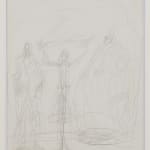-
Artworks
Alberto Giacometti Swiss, 1901-1966
Double Face, c. 1951Double-sided pencil drawing
Front: « Personages », circa 1951
Back: « Portrait of a man »40.3 x 33.9 cm (15 7/8 x 13 3/8 in.)
Frame: 63 x 56 cm (24 ¾ x 22 in.)
With stand: H 74.5 cm (29 3/8 in.)Further images
Alberto Giacometti is known for his sculptures, paintings, his wafer-thin walking men, his static women, his heads that stare but don't see. He always had a pencil to hand and never stopped drawing, in the street, at the café, at friends' or in his studio. He considered drawing to be « the basis of everything ». His drawing, although not preparatory, was nevertheless the basis for his work as a painter and sculptor. It allowed him to see. Alberto was brought up in a family of artists and served his apprenticeship naturally : in his father's studio and library in Stampa, in Val Begraglia in the heart of the canton of Graudünden. As a child he was gifted. With the stroke of a pencil he portrayed his father and Annetta, his mother, his brothers Diego and Bruno. As a teenager he unapologetically tackled his elders by copying Dürer and Rembrandt. Throughout his life, while still painting and sculpting, Giacometti continued to explore his familiar world with a pencil in hand: he drew numerous portraits, but also apples, glasses, chandeliers, nudes, his Montparnasse studio in rue Hippolyte-Maindron, his family living room in Stampa, where he went to recharge his batteries, or the mountain opposite when he returned home. At the early stages of his career, the line was careful and precise. When doubt set in, the line became vigorous, angry, through desperation at not being able to put to paper what he could see. Giacometti accumulated, piled on the lines. He rubbed out to obtain light effects. The portraits particularly, the figures too from which a dramatic power emanates, seem incomplete. The faces are made up of a tangle, a turmoil of lines. Giacometti wasn't looking for resemblance. He tried to portray the presence of the other, before it was too late. The exercise of drawing was the necessary means for Giacometti to « see », and the white of the paper was the most immediate place, the most worrying too, an « endless » attempt - as it always began again - to portray in space and in light, the living presence of the person or object facing him.Alberto Giacometti is known for his sculptures, paintings, his wafer-thin walking men, his static women, his heads that stare but don't see. He always had a pencil to hand and never stopped drawing, in the street, at the café, at friends' or in his studio. He considered drawing to be « the basis of everything ». His drawing, although not preparatory, was nevertheless the basis for his work as a painter and sculptor. It allowed him to see. Alberto was brought up in a family of artists and served his apprenticeship naturally : in his father's studio and library in Stampa, in Val Begraglia in the heart of the canton of Graudünden. As a child he was gifted. With the stroke of a pencil he portrayed his father and Annetta, his mother, his brothers Diego and Bruno. As a teenager he unapologetically tackled his elders by copying Dürer and Rembrandt. Throughout his life, while still painting and sculpting, Giacometti continued to explore his familiar world with a pencil in hand: he drew numerous portraits, but also apples, glasses, chandeliers, nudes, his Montparnasse studio in rue Hippolyte-Maindron, his family living room in Stampa, where he went to recharge his batteries, or the mountain opposite when he returned home. At the early stages of his career, the line was careful and precise. When doubt set in, the line became vigorous, angry, through desperation at not being able to put to paper what he could see. Giacometti accumulated, piled on the lines. He rubbed out to obtain light effects. The portraits particularly, the figures too from which a dramatic power emanates, seem incomplete. The faces are made up of a tangle, a turmoil of lines. Giacometti wasn't looking for resemblance. He tried to portray the presence of the other, before it was too late. The exercise of drawing was the necessary means for Giacometti to « see », and the white of the paper was the most immediate place, the most worrying too, an « endless » attempt - as it always began again - to portray in space and in light, the living presence of the person or object facing him.Provenance
Diego Giacometti Collection
Private Collection, given to John Constantin (Diego's step-son) by Diego Giacometti
Francis Briest Sale Twenty-Seven works by Alberto Giacometti, Jun 20th, 1995; lot n° 26, repr. p. 31
Bought during this sale by the current owner
Publications
This work was listed in the Alberto and Annette Giacometti Association archives in 1994.
The work was referenced by the Alberto and Annette Giacometti Foundation under the number 2782. A certificate of authenticity was issued by the Giacometti Committee in September 2013.
A statement of provenance, dated 24.6.1994 will come with this work.
Join our mailing list
* denotes required fields
We will process the personal data you have supplied in accordance with our privacy policy (available on request). You can unsubscribe or change your preferences at any time by clicking the link in our emails.







